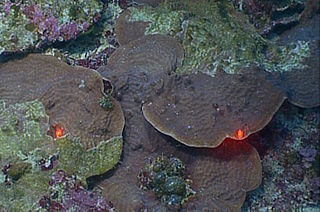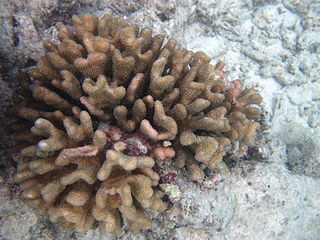
Montastraea is a genus of colonial stony coral found in the Caribbean seas. It is the only genus in the monotypic family Montastraeidae and contains a single species, Montastraea cavernosa, known as great star coral. It forms into massive boulders and sometimes develops into plates. Its polyps are the size of a human thumb and fully extend at night.

Pillar coral is a hard coral found in the western Atlantic Ocean and the Caribbean Sea. It is the only species in the monotypic genus Dendrogyra. It is a digitate coral -that is, it resembles fingers or a cluster of cigars, growing up from the sea floor without any secondary branching. It is large and can grow on both flat and sloping surfaces at depths down to 20 m (65 ft). It is one of the few types of hard coral in which the polyps can commonly be seen feeding during the day.

Pulley Ridge is a mesophotic coral reef system off the shores of the continental United States. The reef rests on sunken barrier islands and lies 100 miles west of the Tortugas Ecological Reserve and stretches north about 60 miles at depths ranging from 60 to 80 meters. Pulley Ridge was originally discovered in 1950 during a dredging operation conducted by an academic group from Texas. While well known to fishermen, this remarkable habitat remained undiscovered by scientists until 1999 when the U.S. Geological Survey (USGS) and graduate students from the University of South Florida happened upon it. This reef system, like other mesophotic ecosystems, is inhabited by photosynthesizing corals and algae that are adapted to low-light environments. It is habitat for numerous species of bottom fish including Epinephelus morio spawning area.

Precious coral, or red coral, is the common name given to a genus of marine corals, Corallium. The distinguishing characteristic of precious corals is their durable and intensely colored red or pink-orange skeleton, which is used for making jewelry.

Acanthastrea echinata, commonly known as the starry cup coral, is a species of corals in the family Lobophylliidae. It is a wide-ranging species found from the western Indian Ocean, throughout the Pacific Ocean, and eastward to the southeastern Atlantic Ocean. It can inhabit any reef habitat to depths of 50 m. This species, which may become threatened with the global decline of coral reefs, is a popular coral used in aquariums.
Tanaocheles is a genus of crabs, the only genus in the family Tanaochelidae. It contains two species, T. bidentata and T. stenochilus. The two species were formerly placed in different families, and they were only shown to be related, and placed in a new subfamily, in 2000.

Teluk Cenderawasih National Park is the largest marine national park of Indonesia, located in Cenderawasih Bay, south-east of Bird's Head Peninsula. It includes the islands of Mioswaar, Nusrowi Island, Roon, Rumberpon, Anggrameos and Yoop. The park protects a rich marine ecosystem, with over 150 recorded coral species, for which it is considered a potential World Heritage Site.

Gersemia is a genus of soft corals in the family Nephtheidae. Species in this genus are found in cold temperate and polar seas at depths ranging from 20 metres (66 ft) to over 2,000 metres (6,600 ft). The type species is Gersemia loricata.

A mesophotic coral reef or mesophotic coral ecosystem (MCE), originally from the Latin word meso (meaning middle) and photic (meaning light), is characterized by the presence of both light-dependent coral and algae, and organisms that can be found in water with low light penetration. Mesophotic coral ecosystems occur at depths beyond those typically associated with coral reefs as the mesophotic ranges from brightly lit to some areas where light does not reach. Mesophotic coral ecosystem (MCEs) is a new, widely adopted term used to refer to mesophotic coral reefs, as opposed to other similar terms like "deep coral reef communities" and "twilight zone", since those terms sometimes are confused due to their unclear, interchangeable nature. Many species of fish and corals are endemic to the MCEs making these ecosystems a crucial component in maintaining global diversity. Recently, there has been increased focus on the MCEs as these reefs are a crucial part of the coral reef systems serving as a potential refuge area for shallow coral reef taxa such as coral and sponges. Advances in recent technologies such as remotely operated underwater vehicles (ROVs) and autonomous underwater vehicles (AUVs) have enabled humans to conduct further research on these ecosystems and monitor these marine environments.

Herpolitha is a monotypic genus of mushroom corals in the family Fungiidae. The only member of the genus is Herpolitha limax, commonly known as the tongue, slipper, mole or striate boomerang coral. It is a free-living species and is native to reefs and lagoons in the Indo-Pacific region. The International Union for Conservation of Nature has assessed this coral as being of "least concern".

Dactylotrochus is a genus of large polyp stony corals from the Red Sea and western Pacific Ocean. It is monotypic with a single species, Dactylotrochus cervicornis. It inhabits the deep sea and is believed to be azooxanthellate.
Acropora elegans is a species of acroporid coral that was first described by Henri Milne-Edwards in 1860. Found in sheltered, sloping reefs, this species occurs at 30 to 60 m depth. The species is listed as vulnerable on the IUCN Red List, and has a decreasing population. It is not common and has a small range, and is listed under CITES Appendix II. It is more resistant to disease than other Acropora species.
Acropora hoeksemai is a species of acroporid coral that was first described by Dr. Carden Wallace in 1997. Found in shallow reefs in a marine environment, it is found at depths of 8 to 20 m. It is listed as a vulnerable species on the IUCN Red List, and has a decreasing population. It is common, listed on Appendix II of CITES, and is found over a large range.
Acropora kosurini is a species of acroporid coral that was first described by C. C. Wallace in 1994. Found in marine, shallow reefs, it occurs at depths of 8 to 20 m. It is listed as a vulnerable species on the IUCN Red List, and it is believed to have a decreasing population. It is rare but found over a large area, and is listed on CITES Appendix II.
Acropora loisetteae is a species of acroporid coral that was first described by C. C. Wallace in 1994. Found in marine, tropical, shallow reefs in sheltered lagoons, it is found at depths between 1 and 30 m. It is listed as vulnerable on the IUCN Red List, and it is thought to have a decreasing population. It is not common but found over a large area, and is listed under CITES Appendix II.
Acropora pharaonis is a species of acroporid coral that was first described by Milne-Edwards and Haime in 1860. Found in marine, tropical, reefs on slopes sheltered from wave action, it occurs at depths of between 5 and 25 m. It is classed as a vulnerable species on the IUCN Red List, and it has a decreasing population. It is common and found over a large area and is classified under CITES Appendix II.

Pocillopora elegans is a species of colonial stony coral in the family Pocilloporidae. It is native to tropical and subtropical parts of the western, central and eastern Pacific Ocean. It is susceptible to bleaching and various coral diseases and the International Union for Conservation of Nature (IUCN) has listed it as a "vulnerable species".

Astrobrachion constrictum is a basket star in the family Euryalidae. It is mostly found at depths of between 50 and 180 m, but around the coast of New Zealand it occurs in shallow waters, in association with the black coral Antipathella fiordensis.

Heteropsammia is a genus of apozooxanthellate corals that belong to the family Dendrophylliidae.














